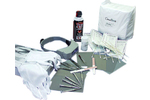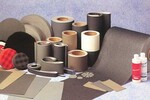Description
A Power Tool Version with loop back discs for use with a power drill or other rotary tool.
Contents
3KHDKIT contains:
- 1 - 3" Disc 120
- 1 - 3" Disc 220
- 1 - 3" Disc 400
- 1 - 3" Disc 1500
- 1 - 3" Disc 2400
- 1 - 3" Disc 3600
- 1 - 3" Disc 4000
- 1 - 3" Disc 12000
- 1- 3" Lambs Wool Buffing Pad
- 1 - 2 OZ. Bottle MICRO-GLOSS liquid abrasive
- - 11" x 12" Flannel Sheet
3KHDLGTM (new) contains:
- 2 - 120 Grit wet/dry sandpaper 3" loop discs
- 2 - 220 Grit wet/dry sandpaper 3" loop discs
- 2 - 400 Grit wet/dry sandpaper 3" loop discs
- 2 - 1500 Micro-Mesh 3" loop discs
- 2 - 2400 Micro-Mesh 3" loop discs
- 2 - 3600 Micro-Mesh 3" loop discs
- 1 - 3" TufBuf lambswool buffing pad
- 1 - 4 oz. bottle Micro-Gloss liquid abrasive
- 1 - Instructions
Instructions - 3KHDKIT
List of Contents:
3" x 4" Soft Touch Pads: 120/220, 400/1500, 2400/3600, 4000/12000, 1 oz. Bottle Micro-Gloss®, and 2 cotton flannel wipes.
Determine Type and Extent of Damage and Starting Point
Crazing - A series of very fine lines, stars, or haze when viewed at an angle in bright light. Crazing is below the surface and usually cannot be felt with the fingernail and requires aggressive sanding to remove. Begin with the 120 pad.
Deep Scratches - Easily felt with the fingertip. Begin with the 220 pad.
Minor Scratches - Readily detected with fingernail. Begin with the 1500 pad. If the scratch is not easily removed use the 400 pad followed by the 1500 pad.
Hairline Scratches & Light Scuffs - Light scratches and hazing - Begin with the 2400 or 3600 pad.
Very Fine Scratches - Usually caused by improper cleaning methods. Begin with the 4000 pad.
Step 1 - Damage Removal
1. Determine your starting point. The Soft Touch Pads can be used wet or dry, but best results are obtained if used wet. This will also help keep the surface cool and the pads free of abraded particles. Clean, fresh water is an excellent lubricant and coolant. Water may be sprayed or misted onto the pad's surface or dip pads in fresh water occasionally during use. A drop of mild dish detergent can be added to water for lubrication if needed.
2. DO NOT SAND IN A CIRCULAR PATTERN. Spot sanding in a localized area is not recommended. Using firm pressure, sand evenly over the entire area in a vertical motion, until the damaged layer has been totally removed. Sand the entire surface before going onto the next step. This damage removal step is CRITICAL! If it is incomplete, the final results will not be satisfactory. After 3-5 minutes check your progress. If it seems the damage is not being removed at an acceptable rate, you may want to go to a coarser pad. In the case of crazing, the time needed to remove the damage will be longer. Since more material will be removed to eliminate damage, you may want to alternate with vertical and horizontal straight line motion. Once the damage has been removed, end with a vertical sanding pattern.
3. Clean the surface by flushing with water, or blowing with air.
4. Proceed to the next finer Soft Touch Pad. Pads range from coarse to fine:
120, 220, 400, 1500, 2400, 3600, 4000 and 12000. Sand at a 90° angle from the
previous step. Continue sanding until the previous sanding pattern has been
completely removed. If water is being used, it will be necessary to dry the
surface completely to determine that the previous pattern has been removed. The
use of 100% cotton flannel is recommended. Avoid synthetics and paper towels, as
these both tend to cause scratches in plastic.
Step Two - Surface Restoral
1. After the surface has been sanded with the 400 pad, begin with the 1500 pad, and sand at a 90° angle from the previous sanding pattern. Continue until the previous pattern is again removed.
2. Proceed as above through all Soft Touch Pads included in the kit. Be sure to change the sanding direction 90° with each step and check for total removal of each scratch pattern. If coarser scratches remain at any step, they will probably still be visible at the end leaving an incomplete restoral and a hazy finish.
3. When you have finished with the 12000 Soft Touch Pad, and are satisfied with the surface appearance, clean the surface thoroughly.
4. Once the surface has been sufficiently cleaned, flush with water. Using one of the flannel cloths included in this kit, wipe the lens. Dampen the flannel with water and apply a dime size drop of Micro-Gloss to the flannel. Rub briskly over a square foot area. Work in a straight line pattern. Use firm pressure for 1 to 2 minutes, until Micro-Gloss has almost disappeared. Water may be added to extend working time. Continue in 1 foot areas, overlapping slightly until the entire surface has been worked. Rinse the surface with water and wipe clean. Dry with the second flannel cloth.
Note: Keep the flannel clean and you can use it many times. Rinsing is needed to remove dirt and abrasive particles that are trapped in the flannel. Rinse and dry the Micro-Mesh Soft Touch Pads and store for reuse in the future. Keep the Micro-Gloss from freezing temperatures.
Clean lenses on a regular basis with Micro-Gloss to keep them looking like new.
03/15/03 - HLRK Instructions
Instructions - 3KHDLGTM
MECHANICAL HEADLIGHT KIT #3KHDLGTM
Drivers and passengers alike need and appreciate the clear view that well maintained headlights provide. Comfort, enjoyment, but more importantly - SAFETY, are all requirements today! The smallest of scratches can lead to crazing. By keeping headlights smooth and optically clear, through regular maintenance, crazing can be avoided.
A. TOOLS REQUIRED:
- 1. (1) Cordless rotary power drill
- 2. (1) Spray bottle - approximately 10 ounce capacity. (For clean water).
B. LIST OF CONTENTS:
- 1. (2) 120 Grit Wet/Dry Sandpaper 3" Discs 6. (2) 3600 Micro-Mesh 3" Discs
- 2. (2) 220 Grit Wet/Dry Sandpaper 3" Discs 7. (1) 3” Back-up Pad
- 3. (2) 400 Grit Wet/Dry Sandpaper 3" Discs 8. (1) TufBuf polishing pad
- 4. (2) 1500 Micro-Mesh 3" Discs 9. (1) (4 ounce) Micro-Gloss
- 5. (2) 2400 Micro-Mesh 3" Discs 10. (1) Instructions
C. DETERMINE TYPE AND EXTENT OF DAMAGE AND STARTING POINT
1. If your headlights are extremely hazy, yellowing or seriously damaged you will need to start with the 120-wet/dry sandpaper. Make sure you remove damage with that first step. (Note: when finished with the first step it is going to look worse).
2. If you have slight haziness, cloudiness or slightly scratch headlights start with the MicroMesh ®1500 then follow the consecutive larger numbered grades and buff with MicroGloss® and Tufbuf Polishing Pad®.
D. THE PROCESS:
1. Mask off with heavy duct tape. Wet the surface. All sanding is done wet. Use firm even pressure to control the drill. Start the drill after contact with the surface. Start with the 120-grit wet/dry sandpaper or with the 1500 Micro-Mesh®. Cover the entire surface of transparency with long, sweeping motions. At regular intervals, change the directions of sweep to perpendicular of the previous motion. The damage is removed when all that can be seen is the pattern left by the sandpaper or Micro-Mesh®. Then continue with the next grades of abrasives until you finish with the 3600. The remaining steps should take 3-5 minutes per square foot for each grade. Remember to wipe debris clear between each step.
2. Attach the TufBuf polishing pad to the drill back-up pad. Wet the surface with water. Apply approximately 1 tablespoon of Micro-Gloss® and buff for 2-4 minutes. Re-wet the surface and add more Micro-Gloss®, if necessary.
IMPORTANT NOTICE: Micro-Surface Finishing Products, Inc. (“Micro”) MAKES NO WARRANTIES, EXPRESS OR IMPLIED, INCLUDING, BUT NOT LIMITED TO, ANY IMPLIED WARRANTIES OF MERCHANTABILITY OR FITNESS FOR A PARTICULAR PURPOSE. User is responsible for determining whether this product is fit for a particular purpose and suitable for user’s method of application.
LIMITATION OF REMEDIES AND LIABILITY: If this product is proved to be defective, THE EXCLUSIVE REMEDY, AT MICRO’S OPTION, SHALL BE TO REFUND THE PURCHASE PRICE OF OR TO REPAIR OR REPLACE THE DEFECTIVE PRODUCT. Micro shall not otherwise be liable for loss or damages, whether direct, indirect, special, incidental, or consequential, regardless of the legal theory asserted, including negligence, warranty or strict liability.
For technical support contact Micro-Surface Finishing Products, Inc.
TECHNICAL BULLETIN RANDOM ORBITAL SANDING WITH MICRO-MESH!
Random orbital sanders (ROS) move in repetitive forward-left-back-right strokes. The forward left motions often are the most aggressive strokes and may leave semi-circular "fish hook" scratch patterns. The completed motion leaves an elliptical scratch pattern often visible as swirl marks or uneven finishes.
MICRO-MESH , a cushioned abrasive, is designed to allow the abrasive crystals to float on soft "cushioned" backing. The micron-graded crystals recede to a common level and tend to rotate slightly when pushed against the surface. This action causes a uniform level planing action on the surface and contributes to long, even abrasive life.
Sanding in a straight-line pattern with MICRO-MESH and a belt sander or sanding block keeps the abrasive crystals set with a positive rake. When used with a ROS, the abrasive crystals plane on the forward stroke, are skewed slightly on the right stroke, plane backward on the back stroke and are skewed slightly again on the left stroke.
Since the abrasive crystals give a more uniform scratch pattern in the forward and backward stroke, it is better to use a small orbit. The smooth forward and back strokes are short, the skewed side to side motion is minimized. The speed of the orbital can be increased to compensate for the small orbit.
Random Orbital Sanders
Rotation speeds vary from 3,000 to 15,000 rpm depending on manufacturer. The orbit size front and back, left to right also varies with manufacturer and use. Typical orbits are 3/32", 1/16" and 1/4".
An 8,000 to 12,000 rpm ROS machine with a 3/32" orbit generally works well with MICRO-MESH for most soft surfaces. Using a larger orbit (1/8" to 3/16") with a much slower orbit speed (3000 to 5000 rpm) has been used successfully for sanding paint finishes and gel coats. Call 1-800-225-3006 for recommendations regarding your specific finishing operation.
Common finishing problems
Ripples and swirls are typically caused by sanding with an uneven motion, tilting the sander, or working in one spot too long. For best results, sand smoothly with even sweeping motions. On curved surfaces it may be possible to purchase pads that match the curves to be done.
Micro-Mesh
MICRO-MESH discs and sheets are available in Regular and MX grades (see conversion chart) with loop or pressure sensitive adhesive (PSA) backing. We strongly recommend the use of hook & loop systems due to the long useful life of the unique cushioned abrasive material. MICRO-MESH can be reused; rinse with water between jobs.
In general, the Regular grades produce matte through gloss finishes on plastics, coatings, woods, solid surface countertops and other soft surfaces. MX grades are constructed with a slightly stiffer backing, and include several grades coarser than the Regular series. MX is generally used on harder surfaces such as metals and coatings.
Random orbital sanding wet
Keep the surface misted with water. Occasionally wipe the work surface with a cotton flannel or terry towel in order to keep the Micro-Mesh from loading up with sanding particles (swarf).
Random orbital sanding dry
To prevent loading, wipe or blow off swarf from the work piece and MICRO-MESH frequently. When loop back material is used, MICRO-MESH can be pulled off the R.O. Sander pad and slapped a few times against a flat surface to clear it. Dry use increases the chances of trapping hard abraded particles between the sander and the work causing hardto-remove deep random fishhook scratches.
06/01/02 Technical Bulletin-#7
DO’S, DON’TS, CAUTIONS WHEN WORKING WITH MICROMESH®
The polishing of surfaces can be very exacting. Success or failure depends on the technician’s knowledge of, and his ability to follow, an established sequence.
MICRO-MESH® Can be Used by Hand. Wrap the abrasive around a foam sanding block to give you even, uniform pressure during your sanding strokes.
MICRO-MESH® Can be Used With an Electric or Pneumatic Random Orbital Sander. Keep sanders to no more than 3500 rpms. Do not use with high speed die grinders. Ripples and swirls are typically caused by sanding with an uneven motion, tilting the sander, or working in one spot too long. For best results, sand smoothly with even, sweeping motions.
Keep Belt Machines at 5500 Rpms or Less. Adjust pressure and tension so that the contact point allows the abrasive to work without smearing. Typically durometers of 30-40 in rubber are best for a cushioned abrasive or cotton buffing wheels work well. Do not use lubricants containing solvents, alcohol or ammonia that could delaminate the MICRO-MESH®.
Pressure Should be Light. Remember the cushioned abrasive cuts with the abrasive crystal tips. The sharp cutting edges are floating on a resilient matrix. Extreme pressure pushes the tips back into the matrix rendering them ineffective and resulting in surface smearing, burning, and possible orange peel and distortion. If using with a belt machine, polish on the slack of the belt on using a soft contact wheel. If using a random orbital sander, polishing steps may require a soft back up pad between the MICRO-MESH® disc and the sander head.
KEEP EVERYTHING YOU USE CLEAN. This includes equipment, sandpapers, MICRO-MESH®, and all wiping materials. A minor scratch here or there is not a crisis situation, but picking up a piece of metal or other contaminate from the top of a work area can be a disaster. Watch where you set things down.
Acceptable Cleaning and Maintenance Materials: 100 % cotton flannel Genuine chamois, not synthetic or imitation Biodegradable liquid detergent MICRO-MESH® Anti-Static Cream MICRO-GLOSS® polish and cleaner
Unacceptable Cleaning and Maintenance Materials: Paper towels or other paper products Shop towels or synthetic fiber fabrics Commercial window cleaners Any product containing ammonia or solvents or alcohol
Clean the Work Surface between each step, especially in cracks and crevices. Flush surface several times with clean water to remove dust and dirt before touching it with anything. Clean abraded particles from the work piece by rinsing and then dry and inspect.
Inspect the Work Piece between steps with a bright light to ensure you are removing the previous scratch pattern before continuing on.
Keep the Abrasives Clean. Keeping them clean will improve performance and extend life.
To Avoid Scratching the Surface, do not wear watches, rings, or bracelets. Long fingernails should be covered with gloves.
For Superficial and Light Surface Damage, use MICRO-GLOSS® liquid abrasive following the directions on the label of the bottle.
For Deep Damage and Crazing, you will be required to remove the damage firstly with sandpaper and then restore the surface to its original state using MICRO-MESH®. After damage is removed by using sandpaper in a succession of steps from coarse to fine, ie: 120 grit, 220 grit, 400 grit wet/dry, then begin the MICROMESH® series with MICRO-MESH® 1500 and proceed through the series to 12000 or until the original surface is matched.
Use a Straight-line Crossing Pattern. Do not use a circular pattern except in the final hand buffing or antistatic operations. When using a random orbital sander, use sweeping motions from left to right for one grit, then change the pattern to an up and down motion on the next.
Using MICRO-MESH® with Water and a few drops of detergent will generally result in a less effort having to be used and a slightly better finish. Only use enough water to provide lubricity to the surface, but not so much that poor contact is made with the work piece.
DO NOT wear out one of the meshes by trying to make it do too much work on your first step. If your estimated damage is not readily removed, go immediately to the next coarser mesh.
Work an area slightly larger with each step to blend. Working one small area on a highly curved section could create flat spots or distortion.
DO NOT skip steps in either the sandpaper or the MICRO-MESH® series.
Work in a brightly lit area but not in the sun.
Removing the initial damage with the sandpaper series will take up 85% of the restoral time. The MICROMESH series and the buffing procedures will take as little as 15% of the time.
IMPORTANT NOTICE: Micro-Surface Finishing Products, Inc. (“Micro”) MAKES NO WARRANTIES, EXPRESS OR IMPLIED, INCLUDING, BUT NOT LIMITED TO, ANY IMPLIED WARRANTIES OF MERCHANTABILITY OR FITNESS FOR A PARTICULAR PURPOSE. User is responsible for determining whether this product is fit for a particular purpose and suitable for user’s method of application.
LIMITATION OF REMEDIES AND LIABILITY: If this product is proved to be defective, THE EXCLUSIVE REMEDY, AT MICRO’S OPTION, SHALL BE TO REFUND THE PURCHASE PRICE OF OR TO REPAIR OR REPLACE THE DEFECTIVE PRODUCT. Micro shall not otherwise be liable for loss or damages, whether direct, indirect, special, incidental, or consequential, regardless of the legal theory asserted, including negligence, warranty or strict liabilities.
HOW TO DETERMINE IF YOU ARE WORKING ON ACRYLIC OR POLYCARBONATE
REQUIREMENTS:
- 1. 3-WAY MICRO-MESH BUFFER; GRADES 2400 (PINK); 4000 (WHITE); 12000 (GRAY)
- 2. SPRAY BOTTLE OF WATER
- 3. LIGHT SOURCE
PROCEDURE:
Work on an approx. 2" x 2" inconspicuous area of the window
Set a light behind the window so inspection can be easily done
Spray the area with a mist of water
Using the buffing stick - pink 2400, make 6 back and forth, using light strokes. Sand in a horizontal motion.
Now, sanding in a vertical motion, use the 4000 white side of the buffer to cross over and remove the 2400 scratch pattern you put in the window.
Stop and access your progress. You should notice a white, milky slurry forming from the sanding action. This is a combination of the water and small abraded particles of acrylic. Did you remove the 2400 sanding pattern? If so and you have a slurry forming - the window is acrylic.
If not, the window is most likely polycarbonate. Making sure the repair area is wet, continue sanding, but this time use the 12000 MICRO-MESH side of the buffer and sand in a horizontal pattern to try the 4000 sanding pattern.
Using a soft flannel or cotton cloth only, put a dime's worth of MICRO-GLOSS on the repair area and polish and wipe clean.
If your window is polycarbonate ask about our restoral products for POLYCARBONATE.
There are many different grades of both acrylic and polycarbonate, so testing is imperative. In some cases, with polycarbonate, less is best and optical clarity may not be possible. Polycarbonate is much softer than acrylic and is more difficult to repair. It's like sanding on rubber.
Tools to Use With Our Mechanical Kits
WE DO NOT INCLUDE POWER TOOLS WITH OUR KITS
For our "mechanical" kits: Heavy Damage Removal Kit, Light Damage Removal Kit, Maintenance Kit, Polycarbonate Kit, Leading Edge Kit, Clearseas Acrylic Kit and Clearseas Vinyl Kit, you will need power tools that are not sold with our kits. Not including tools allows us to keep the price of the kits to a minimum.
TOOLS FOR SANDING
For best results, we suggest using a RANDOM ORBITAL sander for the sanding portion of the process. The exception to this rule is when using our Leading Edge Kit - for this kit, you will only use a rotary polishing buffer.
RANDOM ORBITAL sanders are also know as DUAL ACTION sanders. The sanding head spins in a random pattern making blending easier. These are also referred to as "finishing" sanders.
The random orbital that you choose to use needs to be rated at approximately 10000 RPMs and needs to have variable speed options. You will actually adjust the sander down in speed, approximately half way or until you can easily control it with one hand. You will need the 10000 RPMs for power, but the lower variable speed for control as you work.
TOOLS FOR BUFFING
The buffing portion of the restoral process is performed using a right angle polisher. This is also known as a rotary buffer. This is the same type of buffer you would use on your automobile to buff the clear coat paint. The pad spins in a stationary orbit.
The buffer that you choose to use should be rated at approximately 2500 RPMs. It is important to keep in this range so that you have enough power to do the job, but not so high of RPMs that you would generate a great deal of heat. It is easier to generate heat with a polisher than with a sander. Heat generation can cause distortion, orange peel, and burning. This is why it is important to always use lubrication, preferably water, when possible.
Unlike with the sanding portion of the process, for most jobs, the standard back-up pad that comes with your buffer will be sufficient to do the job. If you're working on a particularly soft material or are having problems reaching a high gloss finish, then attach an interface pad onto your standard backup pad to give yourself the necessary added cushioning. Most industrial supply stores will carry inexpensive, 5" interface pads. Remember to purchase one that is "Loop to Hook" meaning, the loop on one side of the interface pad connects to the hook facing of your standard buffer and the hook side of the interface will be what you attach your loop backed polishing pads to. All of our kits are supplied with accessories to fit 5" tools. All the Micro- Mesh discs and polishing pads are supplied with LOOP backing so you can get the most value from each kit. All discs and pads can be washed and used over and over.
Sanders and buffers are available as both pneumatic (air) and electric. **We always caution people when using electric tools on wet surfaces.
BACKUP PADS
Your sander and/or buffer come with a standard "backup pad" when you purchase it. This back-up pad is what you attach the Micro-Mesh sanding disc or polishing pad to. The backup pad is sometimes referred to as a "backing plate" or "sanding pad", depending on who you speak with. We refer to it as a "backup pad." This pad is made of foam and has either a "hook" surface or "smooth" surface on which to apply the sanding discs or polishing pads. If you have a back-up pad with "hook" you will need to attach LOOP backed sanding discs. If you have a back-up pad with a "smooth" face, you would attach PSA (pressure sensitive adhesive)backed discs.
The foam in the backup pad on most sanders and buffers that come standard on your tool are usually medium to hard in density. Our mechanical kits all feature our specially made extra soft back-up pad. This back-up pad will easily conform to curvatures and allow you to polish your part to a high gloss finish. The harder the backup pad the more in contact you will be with the part you are finishing and provide a coarser cutting action. This is not what you need when polishing softer material to a high gloss finish. The softer the back-up pad, the easier it will polish.
The back-up pad included with our kit has a male shank with a 5/16" x 24 thread count. There are many good sanders on the market today that will fit this back-up pad. We do not recommend one sander over another.
When and IF to Use a Cordless Drill
If you're uncomfortable using power tools or do not have access to air or electricity hookup, you can use a cordless drill for both the sanding and buffing portions of our restoral process, with satisfactory results.
The exception to this rule would be when using our HEAVY DAMAGE REMOVAL KIT. Any sanding done coarser than with our MICRO-MESH 1500 requires that you use a random orbital sander. A cordless drill simply does not have the power you need for coarse sanding.
We recommend that you have a cordless drill that is completely charged and an extra battery set to go prior to beginning your work. We also caution that when in use, keep the drill parrallel to the workpiece at all times and adjust the speed so that the drill provides a smooth action. Any "skipping" or "jumping" on the work piece will cause "chatter" marks.
The Light Damage Removal, Maintenace and Clearseas Vinyl and Acrylic kits are available with a special, extra soft back-up pad that is on a mandrell that will fit into your cordless drill. This is provided in the kit. You will have to choose the Light Damage Removal DRILL Kit in order to get this back-up pad. If you order the Light Damage Removal Kit - you will receive a back-up pad for a random orbital sander. The same is true for the Maintenance Kit. Make sure and look at the back-up pad in the picture of the kit you are purchasing to make sure you're getting the correct one.
Video
| Part No. | Description | Picture | Quantity In Stock |
Price EA |
Order |
|---|---|---|---|---|---|
| 3KHDKIT | Micro-Mesh Headlight Lens Kit - Power Version | 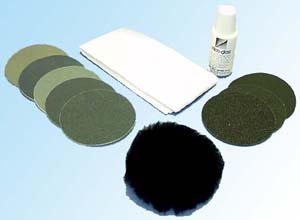 |
2 | $22.88 | |
| 3KHDLGTM | Micro-Mesh Headlight Lens Kit - Power Version - New Style | 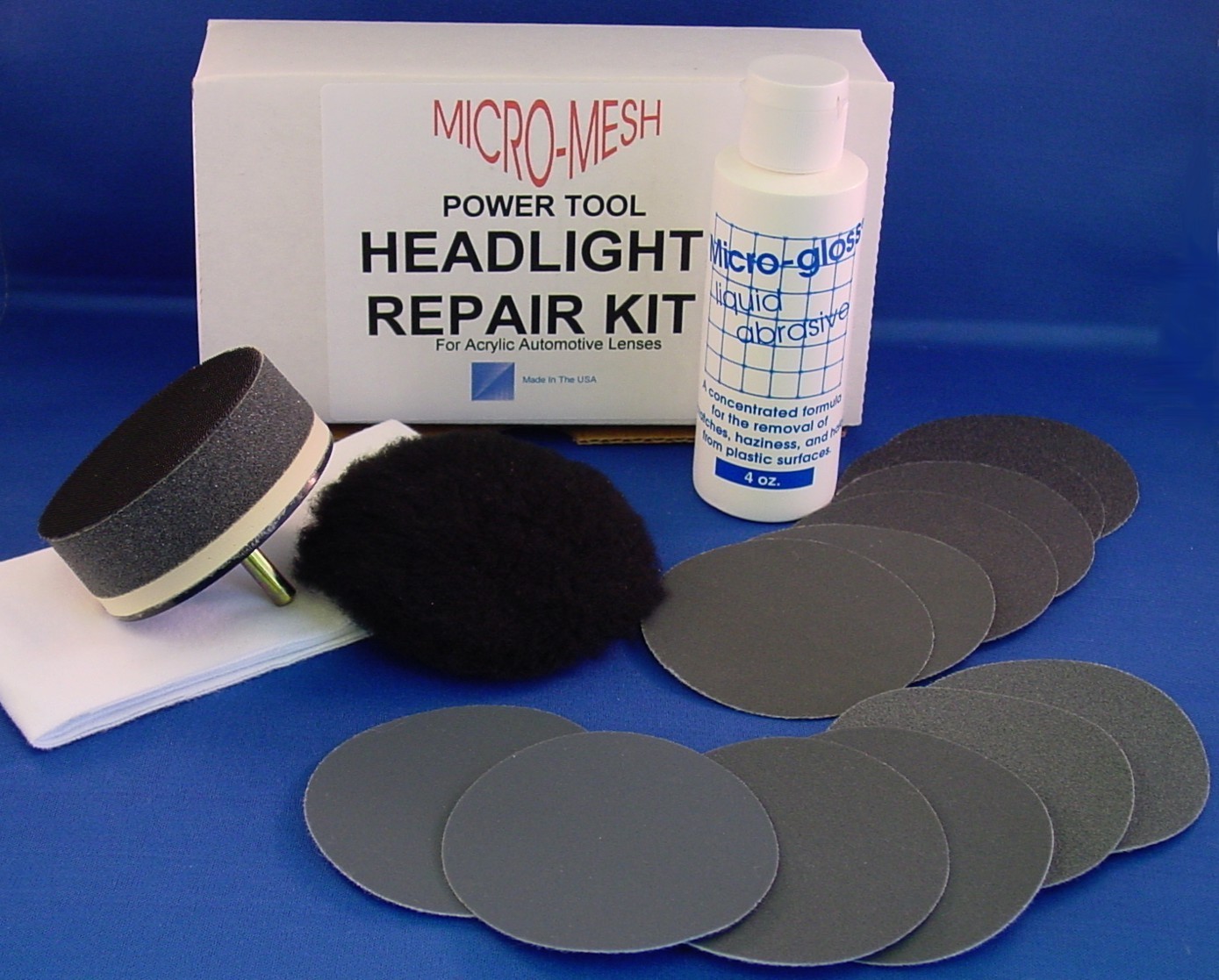 |
0*Lead time for this non-stock item is approximately 7 days. | $43.60 | |
| 3BUPFD3 | 3" DRILL BACKUP PAD |  |
1 | $10.89 | |
| * Lead time for this non-stock item is approximately 7 days. | |||||
|
|
|||||
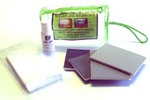 Micro-Mesh® Headlight Kits
Micro-Mesh® Headlight Kits 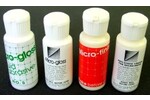 Micro-Mesh® Compound Sampler
Micro-Mesh® Compound Sampler 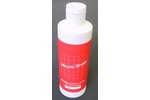 Micro-Mesh® Micro-Finish
Micro-Mesh® Micro-Finish 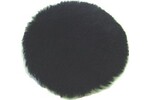 Micro-Mesh® TUFBUF Pads
Micro-Mesh® TUFBUF Pads 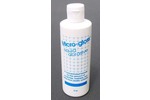 Micro-Mesh® Micro-Gloss
Micro-Mesh® Micro-Gloss 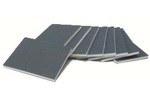 Micro-Mesh® Regular Soft Touch Pads
Micro-Mesh® Regular Soft Touch Pads 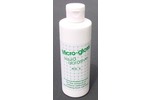 Micro-Mesh® Micro-Gloss 5
Micro-Mesh® Micro-Gloss 5 


